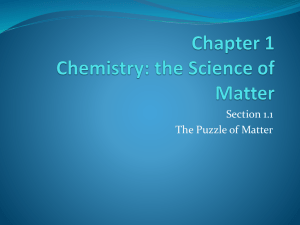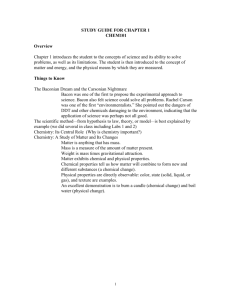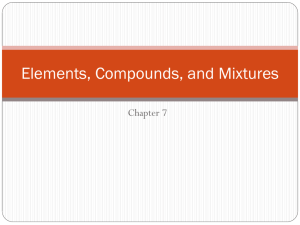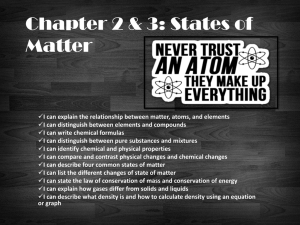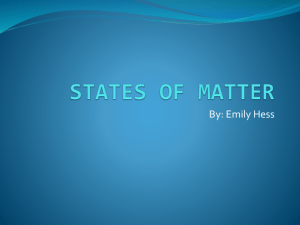Chapter 1 Section 1.1
advertisement
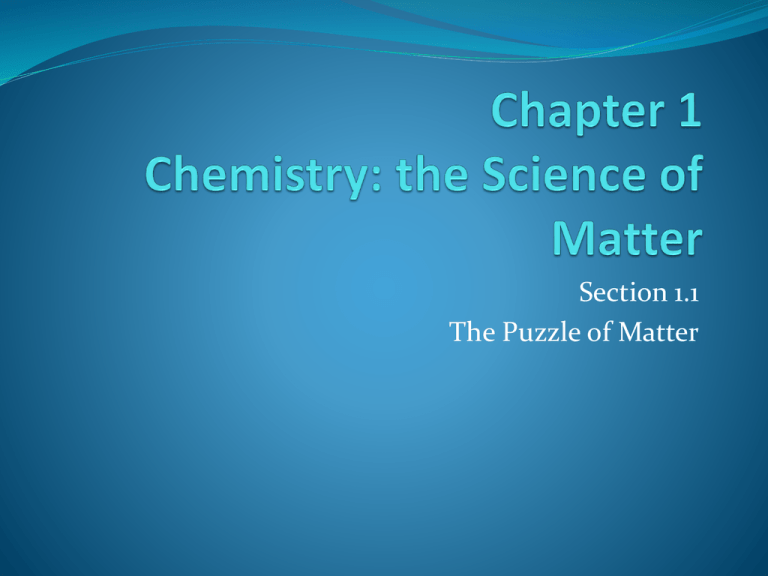
Section 1.1 The Puzzle of Matter Objectives Classify matter according to its composition Distinguish among elements, compounds, homogeneous mixtures and heterogeneous mixtures Relate the properties of matter to structure Chemistry Investigates and explains the structure, composition, and behavior of matter (how it is made and organized) It is the WHAT, HOW, and WHY of stuff Composition and Behavior But what is matter? Matter is anything that takes up space and has mass. …and what is mass? Mass is the measure of the amount of matter that an object contains. Question: What is the SI unit for mass? Properties of Matter Properties describe the characteristics and behavior of matter How do I determine the properties of matter? Examine it Manipulate it (burn it, dissolve it, mix it) Take measurements The Macroscopic View of Matter Macro – prefix – what does it mean? If you can touch, feel, smell, taste or see it, you are viewing matter from a macroscopic perspective The Submicroscopic View of Matter Submicro – prefix – what do you think it means? Submicroscopic So small that you can’t see it with a powerful microscope! You are “viewing” the world of atoms No one has ever seen a single atom, but there is indirect evidence that supports its existence Models in Chemistry Give an example of how a model is used? A scientific model is a thinking device that helps you: 1) Understand and explain the observed behavior of matter 2) Predict behavior that has yet to be observed Must be supported by experiments Models in Chemistry What do the football team, school choir, chemistry class, and U.S. Congress have in common? All composed of people. In the same way aspirin and sucrose have the same kinds of atoms. Classifying Matter QUALITATIVE: Observation without measurement Ex: Strong girl, blue dress, Tall man QUANITATIVE: Observation with measurements Ex: 100 lbs., 5 dresses, Man is 6 ft. tall Pure substance or a mixture? PURE SUBSTANCE: Matter that has the same fixed composition and properties (element or compound) MIXTURE: Combination of two or more substances in which the basic identity if each substance is not changed - composition is variable Pure Substances ELEMENTS: Substances that cannot be broken down into simpler substances (simplest form of matter) There are ~117 elements, 92 occur naturally on Earth COMPOUNDS: Chemical combinations of two or more elements, joined together in fixed proportions with a unique set of properties Mixtures Can be separated through physical processes – name a phsyical process PHYSICAL CHANGE: A change in matter that does not involve a change in the identity of the individual substances Examples: freezing, melting, evaporating, cutting PHYSICAL PROPERTIES: characteristics matter exhibits without any change in its identity Examples: solubility, melting point, density Mixtures 2 Types of mixtures: Heterogeneous: a mixture with different compositions Has clear and distinct regions, called phases. Homogeneous: a mixture that is the same throughout (constant composition) also called a SOLUTION Solutions can have water, gases, solids Mixtures (cont) ALLOYS: solid solutions that contain metals and sometimes nonmetals. No water! Ex: Stainless Steel (Fe, Cr, Ni), Brass (Cu and Zn) Mixtures (Cont) Aqueous solutions: Contain water. Solute: The substance that is dissolved. Solvent: The substance that dissolves the solute. Example: In Kool-Aid what is the solute and what is the solvent? Graphic Organizer Draw on board Graphic Organizer Organizing elements Periodic table organizes elements and provides chemical information. Periodic tables in textbook on p. 90-91, back cover. Chemical symbols are universal shorthand- 1 or 2 letter symbols. Ex: O (oxygen) -corresponds to English name Cu (copper)- corresponds to Latin name (cuprum) Compounds More than 10 million compounds (Common compounds on p. 30) FORMULA: Combination of chemical symbols that shows which elements and how many make up a compound Ex: H2O (water), C12H22O11 (Sucrose) Group Activity: Pure vs. Compound Homogeneous vs. Heterogeneous Grouping/Sorting Matter Activity Sugar and Sand Salt and Water Sulfur (S) Stainless Steel Milk Spaghetti and meatballs Activity Organize the matter from the list below into 2 categories~ PURE and MIXTURE Granola Sugar Sterling Silver Air Diamonds Dihydrogen Monoxide Uranium Ink Natural Gas Bronze Activity Now… Separate your PURE matter into elements and compounds. Activity NOW… Separate your MIXED matter into homogeneous and heterogeneous.

